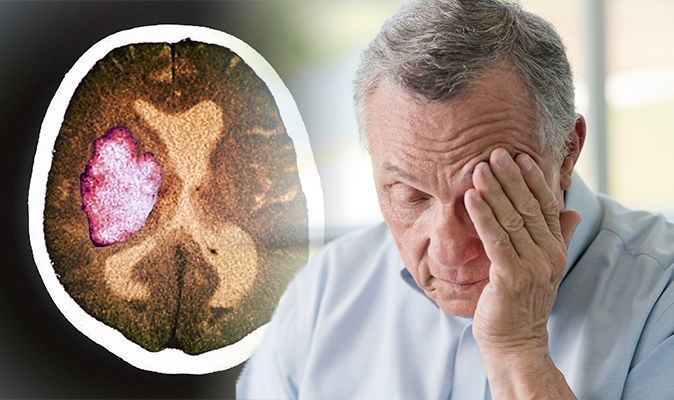Transient ischemic attack (TIA): what is it, symptoms, treatment
Content
- What is a transient ischemic attack?
- Signs and symptoms of TIA
- Other symptoms of mini strokes
- Causes of transient ischemic attack
- Blocked blood vessels cut off blood supply to the brain
- Atherosclerosis
- Blood clots
- Hemorrhage
- Risk factors
- Fixed risk factors
- Age
- Floor
- Ethnos
- Family history
- Lifestyle Risk Factors
- High blood pressure
- Weight and nutrition
- Smoking
- Diabetes
- Diagnostics
- Initial assessment
- Directions
- Surveys
- Blood tests
- Electrocardiogram (ECG)
- Chest X-ray
- Computed tomography (CT)
- Magnetic resonance imaging (MRI)
- Ultrasound examination (ultrasound)
- Echocardiogram
- Treatment of transient ischemic attack
- Drug treatment
- Anti-platelet drug
- Anticoagulant drugs
- High blood pressure medications
- Cholesterol drug
- Surgery
- Carotid endarterectomy
- Prevention of transient ischemic attack
- Weight
- Physical activity
- Healthy eating
- Stop smoking
What is a transient ischemic attack?
A transient ischemic attack (TIA), or “mini-stroke,” is caused by a temporary drop in the blood supply to a part of the brain, resulting in a lack of oxygen in the brain. Subsequently, this can cause symptoms similar to
stroke, although they do not last long. TIA only lasts a few minutes and is usually resolved within 24 hours.Signs and symptoms of TIA

The main signs and symptoms of a transient ischemic attack can be remembered by the FAST abbreviation: F-face (face), A - arm (hand), S - speech (speech), T - time (time).
- Face. The face may fall to one side, the person may not be able to smile, their mouth or eyes may drop.
- Arm. A person with a suspected mini-stroke may be unable to raise and hold both arms due to weakness or numbness of hands.
- Speech. The person may have slurred speech.
- Time. It is time to dial 112 immediately if you see one or more of the above signs.
It is important for everyone to be aware of these signs and symptoms. If you live with and care for someone at high risk, such as an elderly person, diabetic, or someone with high blood pressure, knowing about the symptoms is even more important.
FAST symptoms define most TIAs and strokes.
Other symptoms include:
- loss of vision or partial loss of vision, usually in only one eye;
- dizziness;
- trouble speaking, difficulty communicating, and difficulty understanding what others are saying;
- problems with balance and coordination;
- difficulty swallowing;
- numbness / weakness, leading to complete paralysis of one side of the body;
- loss of consciousness (in severe cases).
Other symptoms of mini strokes

TIA symptoms are temporary and should go away within 24 hours of an attack. The duration of symptoms can vary, but they often disappear within one hour.
You should never put off calling an ambulance in the hope that the symptoms will go away, as stroke treatment should begin very quickly after the first symptoms appear.
Different parts of the brain control different parts of the body, so the symptoms that appear after a transient ischemic attack will depend on which part of the brain is affected.
In some cases, a transient ischemic attack occurs before a full blow, which can lead to serious and irreversible damage. Thus, the sooner the patient receives medical attention, the less likely the person is to have another TIA or stroke.
Even if the symptoms disappear while the person waits for the ambulance to arrive, the victim must still be admitted to the hospital for examination.
After an initial assessment, the victim is likely to be promptly referred to the hospital for a more in-depth assessment and, if necessary, to initiate specialized treatment.
Causes of transient ischemic attack
Blocked blood vessels cut off blood supply to the brain

Blood enters the brain through two main blood vessels (carotid arteries) and two other blood vessels (vertebral arteries). These arteries branch out into a series of smaller blood vessels that help supply blood to every part of the brain.
During a transient ischemic attack (TIA), one of the small blood vessels that supply the brain with oxygenated blood becomes clogged or blocked.
When a blockage occurs in a blood vessel, the blood supply to the brain is impaired. In TIA, the destruction is rapidly resolved and the blood supply to the brain soon returns to normal. With a complete stroke, blood flow to the brain is disrupted for much longer. Without a constant supply of blood, brain cells begin to die.
Blockages in blood vessels are usually caused by narrowing of the arteries or blood clots that form in other parts of the body and travel to the brain.
Atherosclerosis
Atherosclerosis is a common condition that causes narrowing of the arteries. This happens when plaque (fatty deposits) develops on the lining of blood vessels. This can cause the blood vessels to become hard, thickened, and less elastic, making it difficult for blood to pass through them.
Blood clots
A transient ischemic attack can also result from a blood clot forming in a blood vessel and blocking the blood supply to the brain.
A blood clot can be caused by a number of factors, some of which are listed below.
- Heart diseases, such as atrial fibrillationcausing an irregular heartbeat, or heart failure, in which the heart pumps blood weakly.
- Diseases of the blood, such as leukemia (blood cell cancer), sickle cell anemia (an inherited blood disorder), high levels of fat in the blood (hyperlipidemia), abnormally thickened blood (polycythemia), or overproduction of platelets in the blood (thrombocythemia).
Read also:Trigeminal neuralgia: symptoms and treatment
Sometimes a TIA can occur when a blood clot from a blood vessel in another part of the body travels to one of the arteries that supply blood to the brain. This condition is known as embolism.
Hemorrhage
In very rare cases, a TIA can be caused by a small amount of bleeding in the brain. This condition is known as intracerebral hemorrhage.
Risk factors
A number of factors can increase your chances of developing a TIA. Some factors, such as age and gender, are fixed (unchangeable). However, others are subject to change. By making a number of lifestyle changes, you can reduce your risk of transient ischemic attack. Cm. See the Prevention section for more information on how you can do this.
Fixed risk factors

Some of the fixed risk factors associated with TIA are described below.
Age
As a person gets older, the arteries begin to thicken and narrow, increasing the risk of TIA. Most TIAs occur in people over the age of 60, but transient ischemic attack can occur at any age, including children and young adults.
Floor
Men are at greater risk of TIA compared to pre-menopausal women. However, the risk of TIA and stroke increases in postmenopausal women.
It is not fully understood why women are at increased risk of TIA after menopause. However, the female hormones estrogen and progesterone are thought to play a role as they can affect the elasticity of blood vessels. In postmenopausal women, estrogen and progesterone levels drop, which can cause blood vessels to become harder and less elastic.
Ethnos
South Asian, African, or Caribbean peoples have an increased risk of developing high blood pressure and diabetes, so they are at a greater risk of developing TIA.
Family history
If you have a family history of stroke or transient ischemic attack, your risk of TIA increases. However, the risk is relatively low, and having family members who have had TIA does not necessarily mean you will.
Lifestyle Risk Factors
High blood pressure
High blood pressure, or arterial hypertensionis the most potent risk factor associated with TIA. High blood pressure puts additional stress on the blood vessels in the body, causing them to narrow or clog.
Weight and nutrition
A diet low in saturated fat increases the risk of atherosclerosis. If there is too much salt in the diet, it is likely that blood pressure will be elevated, which, like atherosclerosis, is a major risk factor for TIA. Overweight and obesity also make the heart tense and weaken the blood vessels.
Smoking
Smoking can double your risk of TIA or stroke. This is because harmful chemicals in cigarette smoke cause the lining of the arteries to thicken, making blood more likely to clot.
Therefore, smoking cessation is one of the main ways to prevent TIA or stroke. Cm. See Prevention section for more information on how to quit smoking.
Diabetes
Diabetes Type 1 may increase the risk of TIA. This is because type 1 diabetes causes an increase in blood glucose levels, which increases the risk of atherosclerosis (the formation of fatty deposits in the blood vessels).
Diagnostics
If you or someone you know shows symptoms of a transient ischemic attack, you should seek immediate medical attention. This will minimize the risk of further TIA or complete stroke.
Initial assessment
TIAs often end very quickly, so no symptoms may be left by the time you see your GP or other health care provider.
When you are examined, your healthcare professional will ask you in detail about the symptoms you had during the attack. For example, they will need to know how long the symptoms lasted and how they affected you. This will help them rule out other conditions that may have caused symptoms.
Your therapist or healthcare professional may still need your neurologic examination, even if you feel the symptoms have gone. You will have to complete a series of simple tasks to test your skills such as strength, sensation and coordination.
Directions
If a general practitioner or healthcare professional suspects that there has been a transient ischemic attack, you should urgently see a specialist for further examination.
You may be directed to geriatrician or neurologist (a doctor who specializes in the treatment of diseases of the brain and spine) or a consultant who specializes in stroke. Some people may be referred to a specialized TIA clinic, which is available in some hospitals and general practice clinics.
The patient should be referred to a specialist or TIA clinic within 7 days after a transient ischemic attack. If there was more than one TIA within 7 days, the person should be immediately examined by a specialist.
Surveys
Following the TIA, a series of examinations are scheduled to check for any underlying factors or conditions that may have caused the mini-shock. Some of these tests are listed below.
Blood tests
If you have had a transient ischemic attack, you may need a series of blood tests, which may include:
- analysis of arterial pressure - first, blood pressure will be checked, since high blood pressure (hypertension) is one of the main risk factors for TIA;
- blood clotting test - a comprehensive analysis of blood clotting parameters is performed to check how "thin" blood is and how high the likelihood of blood clotting;
- analysis cholesterol - a serum cholesterol test can be used to check cholesterol levels; if you have high cholesterol, you are at greater risk of developing a TIA or stroke;
- analysisglucose - the blood glucose (sugar) level will be checked. High blood glucose levels may indicate that you have diabetes.
Read also:Arachnoiditis
Electrocardiogram (ECG)
An electrocardiogram (ECG) is a test that measures the electrical activity of the heart using a series of adhesive electrodes that are attached to the skin. The ECG can detect any abnormalities in the heart rhythm that could be a sign of conditions such as atrial fibrillation.
Chest X-ray
A chest x-ray may be done to rule out any other medical conditions.
Computed tomography (CT)
Computed tomography (CT) scans use a series of X-rays to produce an image of the inside of the body. It can be used to check for other factors that may have caused a TIA, such as hemorrhage or swelling.
Magnetic resonance imaging (MRI)
Similar to CT scans, magnetic resonance imaging (MRI) scans the inside of the body, but instead of using X-rays, a strong magnetic field and radio waves are used. An MRI can provide more detailed images of the brain and blood vessels than computed tomography.
Ultrasound examination (ultrasound)
Ultrasound uses high-frequency sound waves to produce an image of the inside of the body. You will most likely be assigned an ultrasound scan of the carotid arteries in your neck to see if they are narrowed or blocked. This type of ultrasound scan is sometimes called Doppler scan or duplex scan.
Echocardiogram
An echocardiogram may be given to take an image of the heart to check for various forms of heart disease.
Treatment of transient ischemic attack

If there has been a transient ischemic attack, treatment is necessary to prevent recurrent TIA or complete stroke.
The treatment needed will depend on individual circumstances such as age and medical history. The doctor will talk with the patient about treatment options and talk about the possible benefits and risks.
To reduce your risk of further TIA or stroke, you may be prescribed medications and asked for lifestyle changes. They are described in more detail in the prevention section. Some people may also need surgery as part of a transient ischemic attack.
Drug treatment
Anti-platelet drug
Platelets are blood cells that help it thicken. When a blood vessel is damaged, platelets clump together to form a blood clot to prevent bleeding. Anti-platelet drugs work by decreasing the ability of platelets to clump together and form clots.
If you have had a TIA, it is likely that you will need to take anti-platelet medications.
The most commonly prescribed anti-platelet drugs to prevent TIA are described below.
Aspirin and dipyridamole
Aspirin is the most commonly prescribed antiplatelet agent. It is often taken along with another anti-platelet medication called dipyridamole. Aspirin and dipyridamole are often prescribed together because they are more effective in preventing TIA and stroke when used in combination than when taken alone.
After TIA, aspirin and dipyridamole are usually given for 2 years. After this time, you can stop taking dipyridamole and take a low dose of aspirin instead. You may have to take low doses of aspirin indefinitely, depending on your doctor's judgment.
Taking a small dose of aspirin daily is believed to reduce the risk of TIA by 25%. It can also lower your risk heart attack.
Side effects of aspirin may include:
- stomach irritation;
- stomach upset;
- nausea.
Side effects of dipyridamole may include:
- headaches;
- dizziness;
- nausea;
- diarrhea.
Clopidogrel
Clopidogrel is another anti-platelet antibody usually given only if:
- there are serious side effects from taking aspirin;
- had another TIA despite taking aspirin;
- hypertonic disease.
Side effects of clopidogrel may include:
- diarrhea;
- abdominal pain;
- stomach upset;
- bruising;
- bleeding.
Anticoagulant drugs
Anticoagulant drugs work by lowering the level of certain chemicals in the blood that are needed to help blood clot.
Anticoagulant drugs are usually given only if the blood clot that caused the TIA is associated with the heart. This is often associated with a condition known as atrial fibrillation.
Warfarin
Warfarin is an anticoagulant drug used to prevent further TIAs.
The dose of warfarin you receive must be sufficient to make the blood "thinner" (less clotting), but not enough to cause problems such as internal bleeding.
Since the correct dosage of warfarin is very important, your condition will be closely monitored while you are taking the medication. Blood tests, known as International Normalized Ratio tests (INR).
Bleeding is the most serious side effect of warfarin. If you notice any of the following symptoms while taking warfarin, see your doctor right away:
- blood in urine or feces;
- black feces;
- severe bruising;
- prolonged nosebleeds (lasting more than 10 minutes);
- blood in the vomit;
- coughing up blood;
- unusual headaches;
- in women, heavy or increased bleeding during menstruation or any other bleeding from the vagina.
Read also:Spina bifida
High blood pressure medications
If you have high blood pressure (hypertension), TIA is the reason you may need to take hypertension medications to control the disease. This is because high blood pressure significantly increases the risk of transient ischemic attack or stroke.
There are many different types of medications that can help control blood pressure. Your doctor will tell you which one is right for you. For treatment to be more effective, some people must take a combination of two or three different medicines for high blood pressure.
Cholesterol drug
High cholesterol levels are another factor that can increase the risk of TIA. You can help lower your cholesterol levels by making a number of lifestyle changes, such as eating a healthy, balanced diet.
If cholesterol levels need to be reduced with medication, medications known as statins are usually prescribed. Statins help lower the production of cholesterol in the liver.
Surgery
Carotid endarterectomy
Carotid endarterectomy is an operation that involves removing part of the lining of the damaged carotid artery, as well as any blockage that has developed in the artery.
The carotid arteries carry blood to the brain. When fat deposits build up in the carotid arteries, they become stiff and less elastic, making it difficult for blood to pass through them. This condition is known as atherosclerosis.
If you have atherosclerosis, carotid endarterectomy may be needed to reduce the risk of further TIA or stroke.
Carotid endarterectomy is not suitable for everyone with atherosclerosis. For example, if the arteries are almost completely blocked, carotid endarterectomy is unlikely to help. If you only have a partial blockage in your carotid arteries, you may not be suitable for this type either. surgery because the risk of stroke during the procedure may outweigh the potential benefits of surgery.
Carotid endarterectomy is most suitable for people with mild to moderate blockage of the arteries. In such cases, endarterectomy can reduce the risk of further strokes by more than half.
Prevention of transient ischemic attack
A transient ischemic attack often occurs without warning. Having a TIA is a sign that another TIA or stroke may follow. Further attacks can have more serious consequences or develop into a complete, life-threatening stroke.
Whether you have had a prior TIA or stroke, there are several ways you can reduce your risk of a future TIA or stroke. They are outlined below.
Weight
If you are overweight, your risk of TIA or stroke increases. Being overweight also increases your risk of developing high blood pressure (hypertension), heart disease, and diabetes. Losing excess weight will reduce your risk of TIA and stroke.
Physical activity
Regular exercise can lower blood pressure, which can help prevent many potentially life-threatening conditions, including stroke, heart disease, and cancer. It is also an effective way to maintain a healthy weight and can help fight stress and depression.
Aim for at least 150 minutes (2 hours and 30 minutes) of moderate-intensity aerobic activity (such as cycling or brisk walking) every week.
Healthy eating
Eating a healthy, balanced diet will help you lose weight and also help keep your arteries healthy.
Make sure to eat plenty of fruits and vegetables (at least 5 servings a day) as they are a great source of essential vitamins and minerals.
Fruits and vegetables also contain substances called antioxidants that reduce the risk of stroke by protecting the walls of blood vessels from damage.
Limit the amount of salt you eat to no more than 6 grams per day. Too much salt can raise blood pressure, which increases the risk of TIA and stroke. Don't add salt to your food, and remember that many processed foods contain "hidden" salts. Therefore, always check the nutritional information on the label before purchasing food.
Limiting the amount of saturated fat in your diet will help control your cholesterol levels. Foods high in saturated fat include:
- meat pies;
- sausages and fatty cuts of meat;
- butter;
- melted butter;
- Salo;
- hard cheese;
- cakes and cookies;
- foods containing coconut or palm oil.
If you eat a lot of fatty foods, your arteries will be more at risk of becoming clogged with fatty deposits (plaque).
Also, drinking too much alcohol can increase the risk of TIA or stroke. Therefore, try not to go beyond the recommended alcohol limits.
If you have had a transient ischemic attack, you do not need to give up alcohol entirely. Some studies suggest that drinking small amounts of alcohol (within the recommended daily amount) may actually reduce the risk of TIA or stroke. This is because alcohol can thin the blood. However, always avoid binge drinking. Drinking too much alcohol can raise blood pressure.
Stop smoking
Smoking doubles your risk of stroke. This is because it narrows the arteries and increases the likelihood of a blood clot.
If you quit smoking, you can cut your risk of stroke by almost half. Quitting smoking will also improve your overall health and reduce your risk of developing other serious health conditions, such as lungs' cancer and heart disease.



